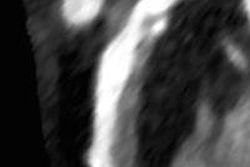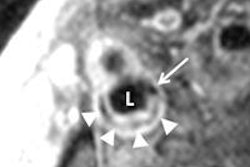A new technique based on near-infrared spectroscopy (NIRS) used during an intravascular ultrasound (IVUS) procedure is the first to directly visualize unstable lipid core plaque, according to an article in the Journal of Invasive Cardiology.
The study included five individuals who experienced sudden cardiac death before being revived and studied with NIRS-IVUS. The technique showed lipid core plaque in all five patients, suggesting that it is reliable for identifying such plaques in vivo.
"The findings are completely consistent with what was previously seen in the pathology literature in patients who died from sudden cardiac death," lead author Dr. Ryan Madder told AuntMinnie.com.
Sudden death the 1st symptom
An estimated 300,000 cases of sudden cardiac death occur each year in the U.S., and tragically, sudden death is often the first sign of coronary artery disease in these patients, wrote Madder and colleagues Dr. David Wohns and Dr. James Muller (J Invasive Cardiol, February 2014, Vol. 26:2, pp. 78-79).
Most cases of sudden cardiac death are due to ruptures of large lipid core plaques, said Madder, an interventional cardiologist at Grand Rapids, MI-based West Michigan Heart, a member of Spectrum Health. The new technique allows physicians to identify cases in patients who are alive.
Previous studies have linked NIRS visualization to culprit lesions across the spectrum of acute coronary syndromes, including in ST-segment elevation myocardial infarction (STEMI), non-STEMI, and unstable angina.
Before the development of NIRS, identifying lipid core plaque in vivo had not been possible; however, this study shows that NIRS and IVUS combined can do so reliably in patients who are alive, the authors wrote.
The article presented findings in five patients who experienced a documented sudden cardiac arrest, were successfully resuscitated, and were then studied with intracoronary NIRS-IVUS to assess the extent and location of lipid core plaque.
One of the cases of cardiac arrest occurred in the emergency room while the patient was awaiting transfer to the cardiac catheterization lab, while the other four cases occurred away from the hospital, including two that occurred prior to first medical contact.
"In all five cases, NIRS identified the presence of a large lipid core plaque in the culprit segment," Madder and colleagues wrote.
But isn't IVUS already used without NIRS for that purpose?
"IVUS is not necessarily able to find the lipid core plaque; it can see what is called attenuated plaque, where the IVUS signal sort of disappears, and they've shown in pathology studies what those arteries contained," he said.
The bottom line is that attenuated plaques seen by IVUS "more than likely have cholesterol in them, but how accurate that is is still a matter of question, because it's not been shown to cause more downstream events than plaques that have not been attenuated," Madder said. Other modalities that can also indicate whether lipid is present in the vessel present the same uncertainties.
"The really nice thing about NIRS is that it's extremely simple to use: Red indicates an absence of lipid and yellow indicates the presence of lipid," he said.
Not noninvasive
NIRS, typically performed by interventional cardiologists, requires a small guidewire to be inserted when the angiography puncture is being performed. It happens "while you're doing IVUS pullback, and it doesn't add any additional time to the procedure," Madder said.
In the five patients, NIRS was performed using the TVC Imaging System by Infraredx. The researchers found a large lipid core plaque in each of the five individuals, and they hypothesized that the lipid was present long before NIRS.
"It was the first study to use NIRS in patients who have experienced cardiac arrest," Madder said. "The day and age may come when we identify those trouble spots and potentially do something about them. But a lot of science needs to take place before that can happen."
For starters, there is no indication that would allow NIRS-IVUS screening in asymptomatic individuals, who represent the vast majority of sudden death cases, he said.
Still, the first large-scale studies were launched this year to further evaluate whether heart attacks can be predicted based on the size, amount, and type of plaque buildup in the coronary arteries, Madder said. Both will use the TVC device to look at lipid-rich plaques, which are implicated in most heart attacks and other cardiac events, according to Infraredx.
The Lipid-Rich Plaque (LRP) study at MedStar Heart Institute in Washington, DC, will follow as many as 9,000 patients for two years to identify and treat lipid-rich plaques in efforts to prevent future coronary events. In addition, the Providing Regional Observations to Study Predictors of Events in the Coronary Tree (PROSPECT) II study from Columbia University Medical Center will examine coronary plaque buildup, following patients for three years to track the occurrence of cardiac events, with an eye toward preventing future heart attacks.



















